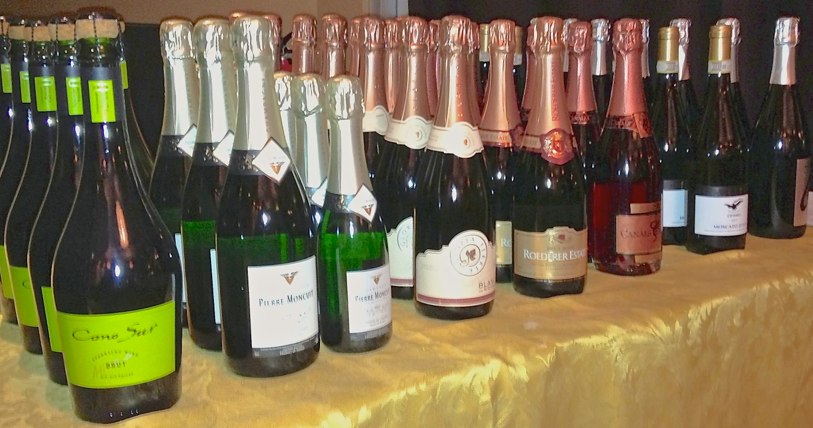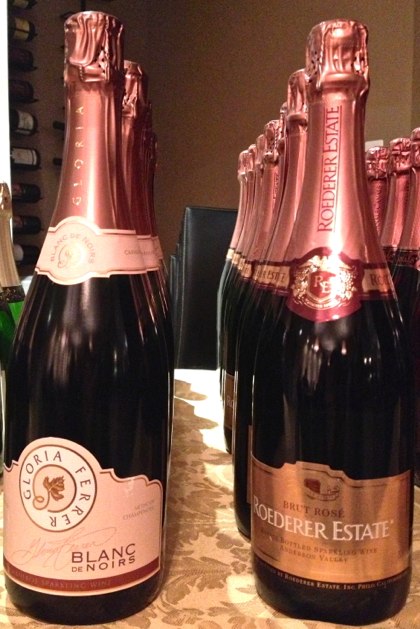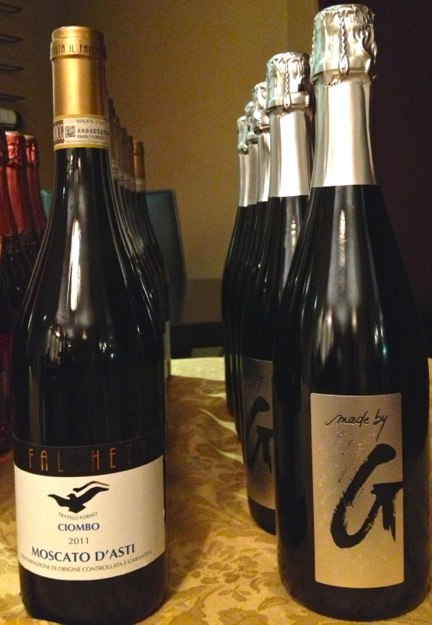I’m always a big fan of sparkling wine, special occasion or none. And the holidays are the perfect time to bring out ANY bubbles.
Last week, I attended an “I Brake for Bubbly” tasting at The Curious Grape, a local wine bar and shop, for a great tour through the sparkling wine world….Austria -> Chile -> France -> Spain -> California -> Italy.
Through this tour you’ll see what makes Champagne, which can only come from Champagne, France, so special, and what the climate, grape varieties and process create for sparkling wines from other regions and countries.
First a little overview about how sparkling wine is made.
- The Traditional Method: The classic way is the méthode traditionelle (traditional method), or méthode Champenoise (Champagne method), developed in Champagne, France. Wine is produced in the normal way, then bottled with a sugar and yeast mixture to sit for a second fermentation. Carbon dioxide is produced during this fermentation creating the tiny bubbles. The yeast cells die and sink to the bottom of the bottle, referred to as the lees. While the wine is aged on the lees, complexity in the flavor develops (Champagne requires a minimum of 15 months for this second fermentation). Next the sediment is removed through ‘riddling,’ the tilting of the bottle on riddling racks to allow the sediment to move to the neck. The neck is then frozen, the cap removed, the plug of frozen sediment shoots out from the pressure. The bottle is then topped up with dosage (small amount of sugar solution, amount added varies based on sweetness and dryness levels desired), recorked and wire caged. Whoosh! Quite a process. Now you know why Champagne is expensive!
- The Charmat Method: This method, also known as the Italian method, is quicker and used to make many less expensive sparkling wines. In this process, the yeast and sugar are added to the wine in the pressurized stainless steel fermentation tanks.Then this wine is bottled.
Now onto the tour…
Flight 1: Austria for Riesling Sekt
 Sekt is the name used for sparkling wine in Germany and Austria. Both wines we tasted are from Weingut Steininger, a small family-owned winery in the Langenlois Valley of Kamptal, one of Austria’s northernmost growing regions. This is a very interesting tasting to compare…
Sekt is the name used for sparkling wine in Germany and Austria. Both wines we tasted are from Weingut Steininger, a small family-owned winery in the Langenlois Valley of Kamptal, one of Austria’s northernmost growing regions. This is a very interesting tasting to compare…
- 2009 Steininger Riesling Sekt, $25.99: The grapes for this wine come from the lower part of the slopes and a nutrient rich soil. It’s 100% Riesling grapes made using the Traditional Method and aged on the lees for at least one year. The result is a bready nose and apple flavors. Very nice!
- 2008 Steininger Riesling “Heiligenstein” Sekt, $51.99: Heiligenstein means Holy Stone and is among one of the world’s most famous vineyards for Riesling. It’s very high altitude vineyards, grown on steep terraces of solid rock. First fermentation for this wine in neutral oak casks is one year, then aged on the lees for two years. No dosage is added. It produces a more concentrated sparkling wine with minerality and stone-fruit with bigger bubbles. A real treat!
Flight 2: Chile & France for Chardonnay-based Sparklers
2011 Cono Sur Brut, Bío Bío, Chile, $18.99: This is a quite nice entry level sparkler made of 90% Chardonnay, 6% Pinot Noir and 4% Riesling. You wouldn’t expect a sparkling wine from Chile, but this one comes from the very southern part of the country, with sunny yet cold weather perfect for growing sparkling wine grapes. While made using the Charmant Method, they age the base wine for four months in barrel before second fermentation, then allow the wine to rest on the lees in tank for three months before bottling. Very balanced with nice minerality!
- Non-Vintage Pierre Moncuit Blanc de Blancs Champagne “Hugues de Coulmet” Brut, Champagne, France, $51.99: Pierre Moncuit is a small boutique producer dating back to the 1940s. Their 36 acres of Grand Cru Village are in the the southern part of the region, which produces some of the region’s best grapes as they are grown in very chalky soil, giving great minerality to the wine. Although this is non-vintage, all Pierre Moncuit’s are made with single vintage grapes. Aged three years for second fermentation in the bottle before disgorgement. Very special boutique Champagne!
Flight 3: Spain & California for Red Grape-based Sparklers
- Non-Vintage Canals Canals Cava Brut Nature Rosat Reserve, Penedes, Spain, $15.99: Cava is sparkling wine in Spain. Cava mainly comes from Penedes region. Cava is made with Spanish grapes using the Traditional Method. This wine is made from Garnacha, Monastrell, Trepat and Pinot Noir. Reserva in Spain means it’s been aged at least 15 months. Brut Nature means no sugar is added to the dosage. Ths wine has been aged 24 months in second fermentation. Very nice!
- 2008 Gloria Ferrer Blanc de Noirs, Carneros, California, $21.99: Carneros is the cold end of the Sonoma and Napa Valley. Founded by Spain’s Freixenet, the second oldest Cava house dating back to 1889 in Spain, they started Gloria Ferrer and planted the first grapes in 1980. Made with the Traditional Method from 92% Pinot Noir and 8% Chardonnay and aged 18 months on the lees, there is also 5% non sparkling rosé added to give it the pretty pink color and creamy round texture. Lovely subtle strawberry and vanilla notes.
- Non-Vintage Roederer Estate Brut Rosé, Anderson Valley, California, $28.99: Roederer Estate Brut is the first California sparkling wine to be produced by Champagne Louis Roederer, the fine winemaker of France. The Anderson Valley is the coolest of California’s sparkling wine regions, also very wet so hard to ripen the grapes. This blend is 60% Pinot Noir and 40% Chardonnay with 5% non-sparkling Pinot Noir added for color. Roederer follows the common Champagne practice of holding a portion of each year’s harvest in “reserve” to enrich the non-vintage blend in any given year. This wine is made of 10-20% reserve wines aged in oak for roundness and aged 24 months on the lees. A Champagne like sparkler from California!
Flight 4: France & Italy for What’s Hot Now
- 2010 Domaine des Nugues “Made by G,” Beaujolais, France, $19.99: This wine from the Beaujolais region is 100% Gamay grapes, however sparkling wines aren’t allowed to be labled Beaujolais, thus the name Made by G. These grapes are hand-harvested and fermented, then fermented again using Traditional Method for a few months on lees. No sugar is added, the sweetness coming just from the Gamay grapes.
- 2011 Tenuata Il Falchetto Moscato d’Asti “Ciombo,” Piedmont, Italy, $17.99: As an Italian wine it is considered Frizzante, their main term for sparkling wines. This wine is made of 100% Moscato grapes and tank fermented. The grapes are grown in the Ciombo region on 25 year old vines. The results is a very intense, floral, honey wine with low alcohol. It’s a perfect after dinner offering.
And that was our flight around the world of sparkling. What’s your favorite sparkling wine?
Cheers to Bubbles!




